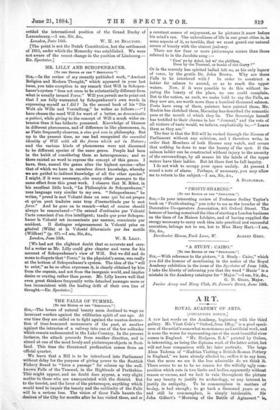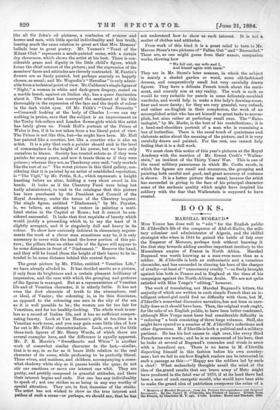ART.
ROYAL ACADEMY OF ARTS.
LCONCLUDING NOTICE.]
A FEW last words on the Academy, beginning with the third gallery. Mr. Vicat Cole's " Oxford, from Iffiey," is a good speci- men of the artist's somewhat monotonous and artificial work, and is none the worse for representing one of the most beautiful river scenes in England. " Mr. Hodgson, R.A." painted by Ouless, is interesting, as being the diploma work of the latter artist, but will not bear comparison with his later portraits. The large Alma Tadema of "Hadrian Visiting a British-Roman Pottery in England," we have already alluded to ; suffice it to say here, that the more we see it the less admirable do we think it. There seems to us to be no reason for the wilfully ugly com- position which cute in two limbs and bodies, apparently without reason or excuse, and we look in vain throughout the picture for any beauty to justify its archasology, or any interest to justify its antiquity. To be commonplace in matters of to-day, is bad enough ; to go back a thousand years or so, and still be commonplace, is simply intolerable. Sir John Gilbert's "Morning of the Battle of Agincourt" like all Sir John's oil pictures, a confusion of armour and horses and men, with little special individuality and less truth, bearing much the same relation to great art that Mrs. Hemans' ballads bear to great poetry. Mr. Yeames's " Toast of the Kitcat Club" represents a much-painted scene, with a certain dry cleverness, which shows the artist at his best. There is con- siderable grace and dignity in the little child's figure, which forms the chief interest of the picture ; and the expression of the members' faces and attitudes are cleverly contrasted. M. Fantin's flowers are as finely painted, but perhaps scarcely so happily chosen, as usual; and Mr. Weguelin's "Herodias " is only admir- able from a technical point of view. Mr. Calderon's single figure of "Night," a woman in white and dark-green drapery, seated on a marble bench, against an Italian sky, has a queer fascination about it. The artist has conveyed the sentiment of his title thoroughly in the expression of the face and the depth of colour in the dark violet eyes. Of Mr. Frith's " Cruel Necessity " —Cromwell looking at the body of Charles I.—we can say nothing in praise, save that the subject is an improvement on the Tenby fish-sellers and London flower-girls which this artist has lately given ns. Frank Roll's portrait of the Prince of Wales is fine, if it be not taken from a too literal point of view. The Prince is not like this, but—he might have been. Mr. Roll has painted like a courtier, but like a courtier who is also an artist. It is a pity that such a painter should sink to the level of commonplace in the height of his power, but we have only ourselves to blame. Society has treated artists as if they were pariahs for many years, and now it treats them as if they were princes ; whereas they are, as Thackeray once said, "only mortals like the rest of us." The worst picture in this third gallery, con- sidering that it is painted by an artist of established reputation, is "The Vigil," by Mr. Pettie, R.A., which represents a knight kneeling before an altar, holding a very short sword in his hands. It looks as if the Chantrey Fund were being but badly administered, to read in the catalogue that this picture has been purchased by the President and Council of the Royal Academy, under the terms of the Chantrey bequest. The single figure, entitled " Diadumenk" by Mr. Poynter, is, we believe, an attempt to restore in painting a muti- lated statue in the Capitol at Rome ; but it cannot be con- sidered successful. It lacks that first requisite of beauty which would justify a proceeding which is, to say the least of it slightly arrogant, and it is singularly dull and heavy in its colour. To show how curiously deficient in elementary require- ments the work of a clever man sometimes may be, it is only necessary to cover with the hand the lower portion of this pic- ture; the pillars then on either side of the figure will appear to be some distance in front of " Diadamene." Remove the hand, and they will be found (from the height of their bases) to be in- tended to be some distance behind this central figure.
The great picture by Mr. Fildes, entitled " Venetian Life," we have already alluded to. It has decided merits as a picture, if only from its brightness and a certain pleasant brilliancy of impression, and the ease with which the grouping and gestures of the figures is managed. Bat as a representation of Venetian life and of Venetian character, it is utterly futile. It has not even the first elements of truth to the atmosphere, real or ideal, of Venice ; the colouring is, in its thin flimsiness, as opposed to the colouring one sees in the city of the sea as it is well possible to be ; the women are far too fair for Venetians, and far too healthy-looking. The whole work is use- less as a record of Italian life, and it has no sufficient compen- sating beauty. Look at Van Haanen's girls at tea-time in a Venetian work-room, and you may gain some little idea of how far out is Mr. Fildes' characterisation. Look, even, at the little three-inch figures of Mr. Henry Woods, of which there are several examples here, and the difference is equally apparent. Mr. P. R. Morris's " Sweethearts and Wives " is another work of somewhat similar character to the last,—similar, that is to say, in so far as it bears little relation to the real character of its scene, while professing to be perfectly literal. These wives, and maidens, and children, accompanying a some- what shadowy white ship as it passes beside the quay, do not stir our emotions or move our interest one whit. They are pretty, and prettily composed in graceful attitudes, and there their interest begins and ends. Not one has any individuality to speak of ; not one strikes us as being in any way worthy of special attention. They are, in fact, dummies of the studio. The artist has not wished to show us the true interest and pathos of such a scene—or perhaps, we should say, that he has not understood how to show us such interest. It is not a. matter of clothes and attitudes.
From work of this kind it is a great relief to turn to Mr. Marcus Stone's two pictures of " Fallen Out " and " Reconciled." These are, as one might guess from their names, companion works, showing how
" We fell out, my wife and I,
And kissed again with tears."
They are in Mr. Stone's later manner, in which the subject is mainly a shaded garden or wood, some old-fashioned dresses, and comparatively small but very carefully drawn figures. They have a delicate French touch about the senti- ment, and scarcely aim at any reality. The work is such as would be very suitable for panels in some delicately-moulded wardrobe, and would help to make a fine lady's drawing-room, finer and more dainty ; for they are very graceful, very refined, and rather an-English in their complexion, the work of an accomplished artist who has set himself no great tasks to accom- plish, but aims rather at perfecting small ones. The " Ento- mologist," by Mr. Marks, is the best of his contributions ; it is a head-and-shoulders portrait of a man who is examining as box of butterflies. There is the usual touch of quaintness and elaborate satire about the meaning of the picture, and it is very carefully drawn and painted. For the rest, one cannot help. feeling that it is a dull work.
We must close this notice of this year's pictures at the Royal Academy with the mention of Mr. Ernest Croft's " Wallen- stein," an incident of the Thirty Years' War. This is one of the usual military panoramas in which Mr. Crofts excels, in which the figures are small and numerous, the grouping and painting both careful and good, and'great accuracy of costume is shown. It is a better picture than usual, because the artist has succeeded in giving to the face of his principal character some of the sardonic quality which might have inspired his soldiery with the fear that Wallenstein is supposed to have created.



































 Previous page
Previous page